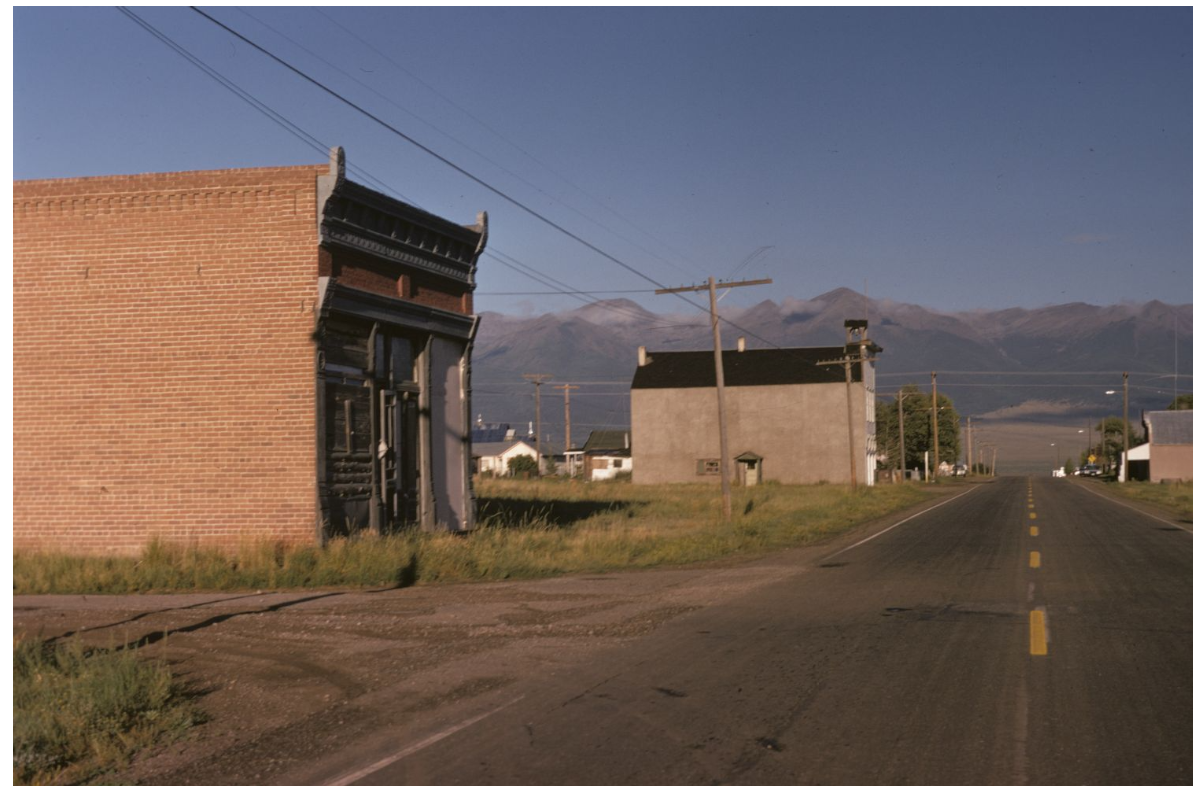(Photo: A mostly abandoned Silver Cliff in 1972. Denver Public Library Special Collections, Z-12892, publication rights purchased)
(Originally published 01/18/2023)
Editorial by Jordan Hedberg
For half a century, local sentiment has focused on wringing its hands about avoiding becoming the next Aspen, Breckenridge, or Vail. Anytime the topic of repairing a street, replacing a waterline, or adding to the school, letters to the editor inevitably revert to fears that “if this is done, our town will be overtaken by outsiders and become Aspen!”
I was surprised at how even talk about a $250,000 grant to the town of Westcliffe, received for Main Street repairs, spiraled on social media into a conversation about how some people don’t want Westcliffe to change, and the state grant was seen as a threat. Any change, even repairing crumbling infrastructure, is viewed as the first step on a slippery slope to mountain gentrification.
In many ways, I am sympathetic and can understand wanting to resist change and growth for their own sake. I have long considered myself a student of Edmond Burke, who is largely considered to be the first Conservative of the Industrial era (late 1700s). Burkean conservatism rests on the idea that the experience, tradition, and customs of a given place should not be lightly tossed aside for the new. In his own words, Burke describes conservatism as “an approach to human affairs which mistrusts both a priori reasoning and revolution, preferring to put its trust in experience and in the gradual improvement of tried and tested arrangements.”

This is not to say that Burke was against change; he just wanted change to be slow and incremental so that society could absorb the changes and correct for unseen side effects. As Burke rightly pointed out at the start of the French Revolution in 1789, the overnight change and destruction of France’s institutions, culture, and history could only end in bloodshed and anarchy, followed by dictatorship. He never saw his prediction come true as he died in 1797, two years before Napoleon Bonaparte took power and after almost 1.3 million French people died in the revolution and the following Napoleonic Wars.
Change, when it is too rapid, can destroy a community, a culture, and individuals as they find themselves alone in unfamiliar cultural surroundings. One of the unexpected side effects of the rapid globalization that followed the end of the Cold War in 1991 was how much damage was wrought on American cities as some areas grew at a dizzying pace (Colorado) and others hollowed out as if a wildfire had torn through old urban centers (Detroit).
The alienating emotional effects on individuals that are ripped from their context due to globalization or change happening too rapidly have happened before. Under the Pax Britannica (British Peace) at the turn of 1900, the world was experiencing a type of laissez-faire (free trade) globalization, the United States had in the 2000s, that abruptly terminated in the muddy trenches of World War I. At the conclusion of the war, the Austrian literary star Stefan Zweig found himself in the same historical and multicultural city of Vienna that had served as the capital city for the Habsburg dynasty that grew into the Holy Roman Empire and was also the capital of the Austrian Empire until the Austro-Hungarian Empire collapsed at the end of the first World War. Yet, with the collapse of the Empire that Vienna had been at the center of for centuries, the new nation-state of Austria left something lacking for Zweig. As the Nazis gained power in neighboring Germany, Zweig emigrated first to New York and then Brazil. It is clear from Zweig’s memoir The World of Yesterday that the rapid change of the world was too much for him to bear. He committed suicide in Rio de Janeiro with his wife from a barbiturate overdose. The couple were found holding hands.

However, if change that happens too fast can destroy a community, attempts to freeze a community in unchanging amber can also destroy it. From my perspective, the biggest threat to the community in the Valley is the stagnation that has taken hold due to the effects of trying to keep this place from becoming the next Aspen.
I am threading a needle here; what so many people admire about Westcliffe, Silver Cliff, and the surrounding area is the small, quiet quaintness of the area. Heck, we don’t even have a stoplight. The one flashing stop sign was taken down several years ago. But that quaintness comes at a cost. In 2000, the median age of Custer County was 44.9, with the state at 34. By 2023, Custer County had a median age of 60.1, while the median age of Colorado was 36.9. It is estimated that there are 5,335 citizens in Custer County, which excludes secondary homeowners. Of that 5,335, only 14%, or 785 people, are under the age of 18, and even that number should be treated with suspicion as the enrollment at Custer County schools is straddling just 300. Those 65 and over now represent 1,808 citizens. Further, with housing prices now eight times the average working household income in Custer County, with no sign of either a massive wage increase or housing prices dropping by half, the median age will continue to spike in the Valley. It is not clear to me that any community can recover from such a demographic imbalance, and the rules that successfully kept this place from becoming the next Aspen are now aging the community out of existence.
It was wise in the 1970s for locals to recognize that they did not want land sliced up into tiny five-acre lots to remain vacant or attracted meth labs in trailers like what took place in the neighboring San Luis Valley, and created minimum lot sizes for different parts of the county based on water availability and agricultural productivity. But that same mentality of large lot sizes also permeated the towns, and nearly all residential zoning within the town limits of Westcliffe and Silver Cliff are zoned for single-family and large lawn areas. There is no place for younger families to start trying to build starter homes in Custer County due to the high costs of land, water access, and building costs. Unless zoning reform is addressed aggressively, and soon, Silver Cliff and Westcliffe will start looking like the near ghost town of neighboring Gardner instead of looking like Aspen.
Empiricism, that is, looking at past data and trends to make guesses about the future, is a double-edged sword. Experience is a great teacher, and only fools ignore experience. But as the Scottish philosopher David Hume noticed in the 1700’s, the past is not a great predictor of the future, and it can be a trap. The population in the United States and the world is no longer growing at the same rate as it did in the past 50 years. In 1974, the growth rate was 1% per year. In 2021 it was 0.31%, almost 75% less. Percentages do not fully capture the decline in population growth. From 1974 to 2024, the population of the United States grew by 132 million people, adding a third to the population. Estimates show that in the next fifty years, the population will only grow by 48 million, adding only a tenth to the current population. And those estimates are on the higher end. Demographers have been shocked at the sudden decline in fertility that jumped downwards during COVID and has not recovered to 2019 levels.
It is time for the community and its leaders to recognize that the next 20 years will not look like the past 20 years, and that the challenge now is to find a way to pass on the Valley’s community, culture, and history to future generations and avoid Westcliffe and Silver Cliff joining the growing cemetery of Colorado ghost towns. There are ways to promote economic growth without engaging in the suburban sprawl of many fears, and I will be exploring those options in future editorials.
– Jordan Hedberg



